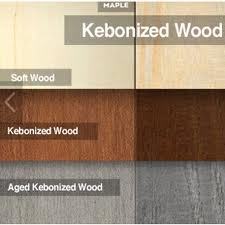Tropical hard wood is often used for its durability and its aesthetics. Deforestation in the tropics is however a problem and increases climate changes. There are nowadays however different alternatives. Softer woods, like european pine, american oak, can be chemically treated and achieve class I hardness and even a more hard wood aesthetic.
Wood:
Examples are Accoya and Kebony.
The technology behind Accoya® wood is based on acetylation. Wood contains an abundance of chemical groups called “free hydroxyls” (represented as OH in the picture). Free hydroxyl groups adsorb and release water according to changes in the climatic conditions to which the wood is exposed. This is the main reason why wood swells and shrinks. It is also believed that the digestion of wood by enzymes initiates at the free hydroxyl sites – which is one of the principal reasons why wood is prone to decay.
Acetylation effectively changes the free hydroxyls within the wood into acetyl groups. This is done by reacting the wood with acetic anhydride, which comes from acetic acid (known as vinegar when in its dilute form). When the free hydroxyl group is transformed to an acetyl group, the ability of the wood to absorb water is greatly reduced, rendering the wood more dimensionally stable and, because it is no longer digestible, extremely durable.
Kebony’s process is based on impregnation with furfuryl alcohol which is produced from agricultural crop waste. Kebony thus uses a plant derived waste product to give enhanced strength and durability to another plant product – namely wood.
In order to reach the required level of polymer in the wood, a traditional impregnation process is used. Although there are constraints in the selection of wood species for a successful impregnation, there is a range of Kebony products based on different species available.
After the impregnation step the wood is heated – whereby the in situ polymerisation of the furfuryl alcohol occurs. This step is referred to as the curing step. The resultant polymer, which is locked into the wood cells, is very stable and will not disintegrate or leak out of the wood.
Joost Vogtlander has calculated the eco-cost of Accoya and came to the conclusion that the eco-cost over the life cycle depend a lot on whether the wood used in the process is sourced local to production or not. If wood is processed in Europe from wood out of New Zealand it is much less sustainable then sourced from european locations. Pick the wood wisely!

Comments by our Users
Be the first to write a comment for this item.